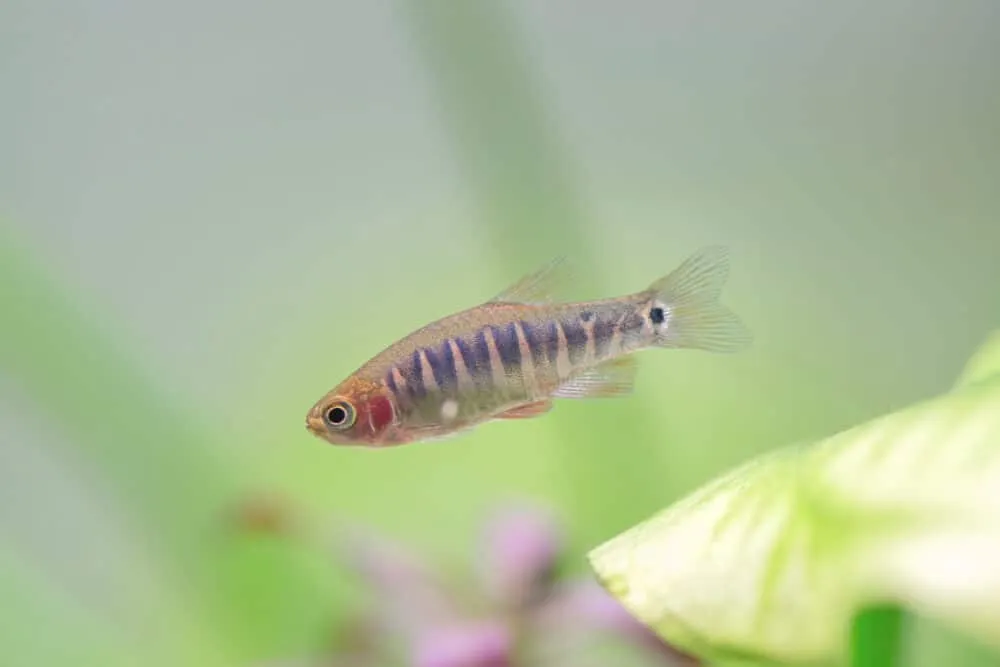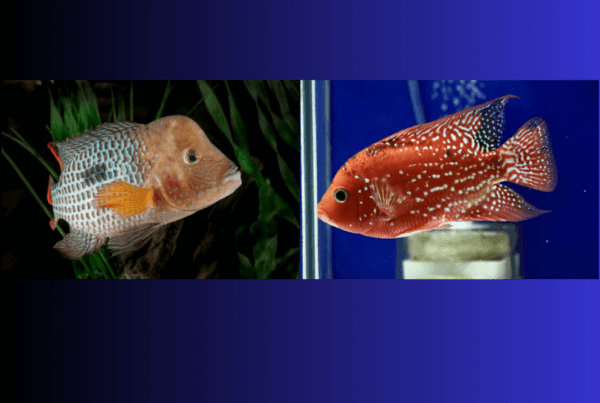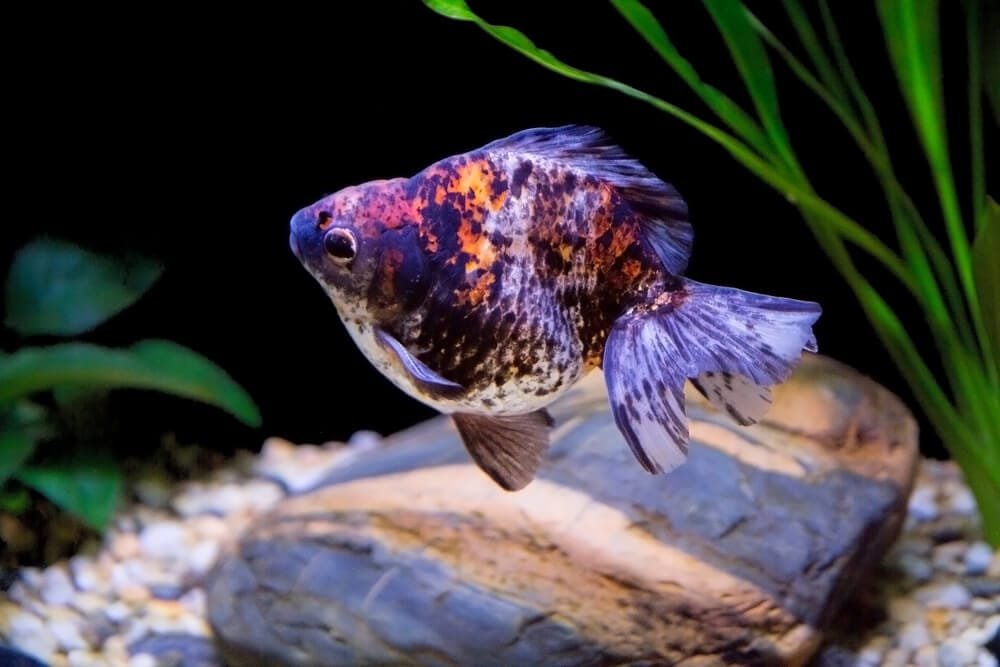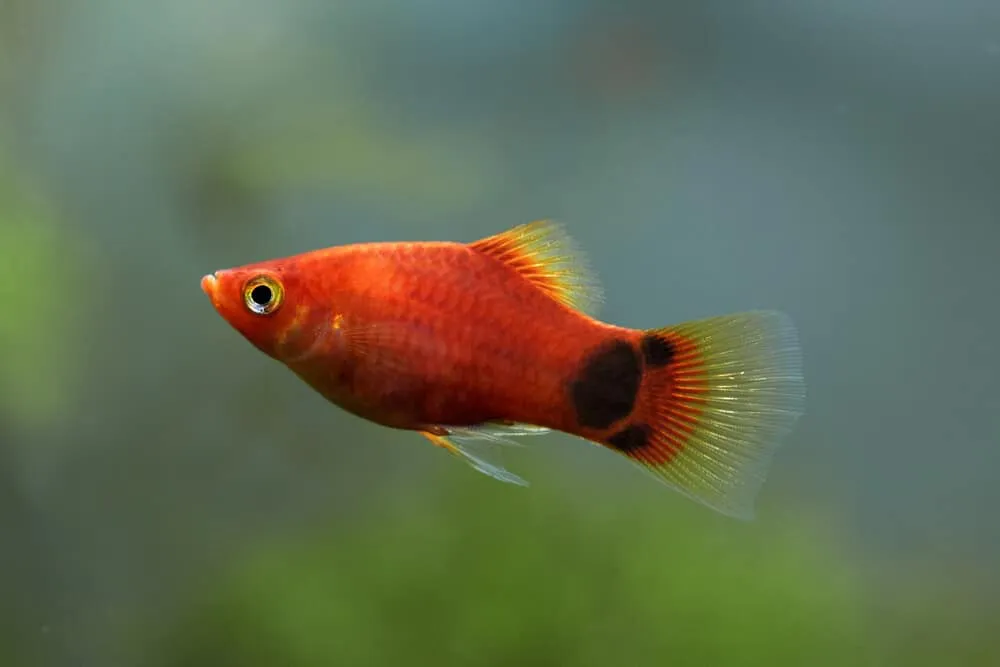Species Overview
Popular Name: Dwarf Danio
Scientific Name: D. erythromicron
Adult Size: Up to 1.7 inches
Life Expectancy: 3 to 5 Years
Characteristics
Family: Danio
Origin: Myanmar
Social: Peaceful
Tank Level: Mid-dweller
Diet: Small insects
Breeding: Laying eggs
Care: Easy
pH: 7.0 to 8.0
Temperature: 70 °F
Water Hardness: Up to 10 dGH
Emerald Dwarf Rasboras are one of the most stunning freshwater fish you can find on the market. However, for some reason, these fish species are not that popular in the aquarium community.
So, if you are looking for the perfect fish that is not commonplace in many hobbyists’ collections, you should consider getting yourself a handful of the Dwarf Rasboras to put in your tank at home.
What’s great about this fish is that it is perfect for all types of fishkeepers; beginner, intermediate, and experienced hobbyists.
They are peaceful, low-maintenance, and hardy fish that easily adapts to a freshwater aquarium environment.
Emerald Rasboras are also undeniably gorgeous and unique-looking. As these fish species are a shoaling type, they would look so delightful as they swim around their tank.
This in-depth guide will walk you through everything you need to know when keeping these Dwarf Rasboras. Once you’re done going through this guide, you will be ready to get some to keep at home.
Overview
These Dwarf Rasboras are scientifically known as Celestichthys erythromicron. This fish specie is tiny, colorful, and with very interesting personalities.
They tend to be quite timid and shy and they do not get aggressive at all. All of these characteristics make the Dwarf Rasboras great tank companions for other small, non-aggressive fish species.
These fish species are shoaling fish and must be kept in a group of at least 10 other Dwarf Rasboras. For this reason, you must keep them in a spacious tank where they can freely roam around.
These Dwarf Rasboras thrive well in a well-decorated freshwater aquarium. Ideally, you must put a variety of plants planted and floating in their tank.
In terms of origin, this specie of fish is endemic in the second-largest lake in Myanmar which is Lake Inle.
This shallow and clear lake is about 6 miles wide and 14 miles long and is packed with captivating greenery and crystal clear waters.
Because Emerald Rasboras are keen on breeding and propagating, their population in the aquarium trade is significantly huge.
Those who are looking for small fish species to add to their tank would highly appreciate this specie’s stunning features and impressive adaptability.
Appearance
Despite the fact that Dwarf Rasboras are fairly small in size, they offer a number of intricate features that are extremely eye-catching.
As their features are quite unique, you will have to see them in person for you to truly appreciate their beautiful looks.
These fish feature long and petite bodies. You will notice that their eyes are fairly large and shimmering and the scales along their gill plates are semi-transparent.
When it comes to their color, they typically have orange or coral pink bodies. Moreover, their entire body is covered by large vertical emerald stripes.
These color combinations create a beautiful glimmer as their bodies are stricken by light as they swim around their tank.
Lastly, at the base of these fish’s tails, you can find a large dot-like shape on either side of their bodies.
This dot-like shape is some sort of mimicry as it looks like an eye and often deceits the predators in their natural habitat in the wild.
Behavior And Temperament
These Dwarf Rasboras are peaceful fish specie that gets along well with other fish in a tank that also has a peaceful temperament.
These fish do not get aggressive at all which is why they make good tank companions for other species as they won’t be bothersome to others.
However, as these Dwarf Rasboras are shoaling fish, they must be kept in groups in order for them to thrive and feel safe.
On the other hand, if they are not kept in large groups, you will notice how shy and skittish they are towards other species inside their tank.
When introducing other tank mates to Dwarf Rasboras, expect that it will take some time for them to get along with other species.
Later on, they will eventually start to mingle and feel comfortable with other peaceful species. However, until then, these Rasboras prefer to stick with others of their own kind.
Average Size And Life Span
The average size for an adult fish is between 1 to 1 and a half inches in length. Obviously, Emerald Dwarf Rasboras are tiny, thus they make great additions to nano tanks.
If you purchase these fish young, they are likely going to be an inch or less in size.
Moreover, as this specie of fish has a constant and swift growth rate, it would only take a couple of months for them to reach their maximum size.
In terms of lifespan, the Dwarf Rasboras are hardy fish and would last up to five years in an aquarium environment if provided with proper care.
Given their small size, a life expectancy of 3 to 5 years is reasonable enough.
In order to help your Dwarf Rasboras live long, make sure to always give them a pristine environment by making sure their tank is clean and the water inside is clear.
Without proper care and hygiene, these fish can become at risk for various diseases and die sooner than their anticipated lifespan.
Tank Size And Setup
Although Dwarf Rasboras are significantly healthy and hardy species, they still need adequate care and proper tank setup and maintenance in order for them to thrive.
In the wild, these fish prosper in lakes that are abundant in greenery. Thus, when keeping them in an aquarium, make sure to replicate their natural habitat as close as you can.
The ideal tank size for keeping these Dwarf Rasboras is a minimum of a 10-gallon tank.
As they are quite small, they don’t need much space, unlike other fish species. However, since they are shoaling fish, they love to swim around in groups, a 10-gallon tank will give a group of 10 to 20 Emerald Rasboras enough area to explore.
However, if you want to provide the best living space for these fish, a 20-gallon tank is a much better option. This tank size will provide extra space for up to 30 adult fish to freely roam around.
Water Parameters
The natural habitat of Dwarf Rasboras in the wild is quite unusual. Lake Inle has crystal-clear freshwaters in a valley that is about 900 meters above sea level.
For this reason, this fish specie favors cooler temperatures with a neutral pH level.
Moreover, these fish do not live well in acidic waters, thus it is best to be very cautious and opt for alkaline waters that are pH balanced.
Take note of these water parameters when putting Emerald Rasboras in an aquarium tank:
Water Temperature: 70°F – 75°F
pH Level: 7-8
Water Hardness: 2 – 10 dKH
Tank Decoration
As mentioned earlier, the natural habitat of the Dwarf Rasboras in a tank is filled with rich greeneries. Thus, when keeping them in a tank, make sure to set up an aquarium environment that looks and feels close to home.
Plenty of aquarium ornaments and dense vegetation are necessary for this fish specie as they often hide in places.
Use plants, driftwood tangles, and ornaments that your fish can use as hiding spots and dwelling spaces.
When putting plants in their tank, aim for leafy ones and some floating varieties.
An artificial driftwood tangle is also ideal as it makes a great hiding spot. However, make sure to pick synthetic driftwood since the natural ones may break up into little debris which could potentially release tannins.
Moreover, it is also recommended to include a dark-toned substrate at the bottom of the tank. A dark substrate mimics the natural loams of their natural habitat at Lake Inle.
In addition, a dark-toned substrate will also bring out the fascinating colors of these fish.
If your Dwarf Rasboras are kept in an undecorated tank with plenty of open spaces, they are likely going to exhibit more shy and skittish behavior or worse, live a stressful life inside the tank.
A well-decorated and vegetated environment provides these fish with a sense of security and the confidence to freely swim around.
Feeding And Diet
These Dwarf Rasboras are omnivorous species. They pretty much eat all kinds of aquarium foods such as pellets and flakes. Additionally, these fish also consume algae occasionally.
When keeping these fish species, you should give them dry food as their main nutrition source.
Opt for commercial fish foods that are rich in nutrition and minerals to maintain the fish’s optimum health. You can also feed them color-enhancing commercial pellets to bring out their natural vibrancy.
When purchasing commercial fish foods, make sure to do your research first and only opt for high-quality food products from trusted brands.
It is also important to note that the Dwarf Rasboras can be picky eaters at times.
Although they generally eat any dry foods, they definitely prefer protein-rich snacks so much more. For this reason, it is ideal to give them some protein snacks every now and then as a treat.
Lastly, these fish also consumes freeze-dried and live foods. You can try giving them baby brine shrimps, daphnia, and bloodworms.
Breeding
The Dwarf Rasboras are keen spawners. In clean and sterile environments, this specie is going to breed and propagate frequently. These fish are egg-scatters, however, they don’t have parental instincts, unlike other species.
To maximize the survival abilities of baby Emerald Rasboras, it is highly recommended to breed them in a pristine, controlled environment.
Have a separate tank when breeding adult Dwarf Rasboras. Have the tank filled with clean, pH-balanced water.
Add in leafy plants or spawning mops as these will help catch the eggs. Once the tank is all set, put in a couple of bonded pairs.
Common Diseases
These Dwarf Rasboras can be prone to all kinds of common freshwater fish diseases including parasitic infection, swim bladder disease, and ich. If not treated adequately in time, these diseases can cause these fish specie’s death.
Ich is a very common yet life-threatening disease among freshwater fish. It is commonly caused by unhygienic and poor water quality in an aquarium tank.
This disease causes itchy white dots all over the fish’s body. If ich is left untreated, the fish can die from it.
What’s even worse about this disease is it is highly contagious and the other fish in the tank can quickly catch it.
Another common disease that the Dwarf Rasboras can be prone to is skin flukes. This disease involves tiny parasites that attach themselves to the fish’s skin and gills.
The infection caused by the flukes can lead to difficulty breathing which can eventually kill the fish. Therefore, it is crucial to treat your fish as soon as possible.
Swim bladder disease is among the more serious ailments freshwater fish including Emerald Rasboras can be prone to. This ailment involves a bacteria that impairs the fish’s swimming ability and buoyancy.
This disease can also be caused by other factors including excessive nitrate content in the water and a sudden temperature change in the water.
Tank Mates
Because the Dwarf Rasboras are small, you must only pick fish species that are close in their size to make sure they don’t get bullied.
Although there are a number of larger species that are peace-loving, there is a risk of them mistaking your rasboras as live foods.
Moreover, it is also crucial that you pick ones that are calm and non-aggressive fish so that both species can live in one tank harmoniously.
Here are a few fish species that would make great tank mates for your Dwarf Rasboras.
1. Small Barbs
These fish are just like Dwarf Rasboras; small, peaceful, and non-aggressive. They make great tank mates as they won’t see each other as a threat given their small size and calm nature.
2. Freshwater Snails
These species are undeniably one of the best tank mates for the Dwarf Rasboras. Not only are freshwater snails extremely peaceful, but they also spend most of their lives wandering around the tank searching for algae and food bits. Thus, they help keep the tank clean and hygienic.
3. Glowlight Danios
These fish are small, peace-loving, and very attractive. Their flashy colors help add life and vibrance to any aquarium environment. Glowlight danios, just like the Dwarf Rasboras, are also shoaling fish that thrive in groups.
4. Cherry Shrimps
Similar to freshwater snails, cherry shrimps are also peaceful scavengers. These species will roam around the tank for food scraps and algae without bothering others.
Cherry shrimps offer a vibrant red color which makes them look absolutely stunning in an aquarium tank.
Frequently Asked Questions
Where are Emerald Dwarf Rasboras originally from?
These Dwarf Rasboras are among the endemic freshwater fish species in Lake Inle in Myanmar. In their natural habitat, these fish dwell in an environment that is abundant in greeneries and clean, crystal-clear waters.
Are Dwarf Rasboras popular?
Although these Dwarf Rasboras are utterly stunning and very easy to take care of, it is not very popular, unlike other fish species.
However, those who have them treat them as a treasure as they are one of the most captivating small fish species you can find in the market today.
Are these fish going extinct?
Fortunately, no. Dwarf Rasboras are not considered extinct. In fact, due to the fact that they are persistent spawners, there is currently a favorable number of them in the wild and in captivity.
What is the ideal tank size and setup for these fish?
The minimum tank size required for keeping a handful of these fish is 10 gallons. However, if you plan to keep about 20 to 30 of them, a 20-gallon tank is a great size.
This is going to be spacious enough for them to shoal and explore around.
What are the ideal plants to put in their tank?
Green plants and a variety of floating plants are the ideal vegetation for the Dwarf Rasboras’ tank environment. Moreover, here is a list of ideal plant variations to include:
- Dwarf Sagittaria
- Anubia species
- Java moss
- Java fern
- Pearlweed
- Ludwigia repens
- Marsilia species
- Green or red lotus
- Sword plants
- Water Sprite
- Vallisneria
- Water wisteria
These plants are low-maintenance and thrive well in waters with low carbon dioxide levels.
Do Dwarf Rasboras have aggressive tendencies?
Not at all. These Dwarf Rasboras are among the calmest and peace-loving fish species in the aquarium community. However, it is important to remember that they are quite shy and timid, especially if not kept in a large group.
What are the typical behaviors of this fish specie?
As mentioned, the Dwarf Rasboras are peaceful species but they can also exhibit skittish and shy behaviors if they are not kept in a large group.
In order to keep them happy and stress-free in an aquarium environment, keep at least 10 of them in the tank. It will give them a sense of security and they are going to feel more confident swimming around.
How big do adult fish get?
If provided with adequate care and nutrition, adult Dwarf Rasboras can grow as much as one to one and a half inches in length.
What are the physical features of the Dwarf Rasboras?
Dwarf Rasboras, despite their small size, have distinctive physical features and coloring which make them stand out in any aquarium tank.
Their bodies are slender featuring an orange or coral pink color. All throughout their bodies, you can see large vertical emerald stripes. At the base of their tale, you can find a black dot-like shape that looks like an eye.
How long do they live?
If given proper care in a pristine, stress-free, and well-vegetated aquarium environment, these Dwarf Rasboras can live as long as five years. The majority of these fish live for as long as their life expectancy of 3 to 5 years.
How do you distinguish the male and female fish?
Generally, adult male fish are smaller in size than females. Another noticeable difference between the male and female fish is the color vibrancy.
Male fish are generally a lot more vibrant in color while the females have a more toned-down coloring.
What should you feed these fish?
These Dwarf Rasboras are omnivorous species and would pretty much consume any commercial fish foods like pellets and flakes.
They also eat freeze-dried foods and live foods such as daphnia and bloodworms. Occasionally, these fish also consume algae.
Moreover, you can also give these fish protein-rich snacks as a treat every now and then.
How to breed my Dwarf Rasboras?
When breeding a pair of adult male and female fish, it is important to put them in a separate tank for more successful spawning.
Make sure the tank has spawning mops and floating plants as these will help catch the eggs and prevent them from being eaten by the fish.
As Dwarf Rasboras are keen breeders, you don’t have to do much once they are in a separate breeding tank.
What fish species should you not put in a tank with the Dwarf Rasboras?
As much as possible, only put similar-size fish species inside the tank with your Dwarf Rasboras. Avoid putting ones that are unfriendly and have aggressive tendencies.
As these Dwarf Rasboras are quite shy and timid, they may live in constant fear and stress if kept in a tank with bothersome fish species.
Are these fish easy to take care of?
These Dwarf Rasboras are among the easiest species to take care of as they are hardy and low maintenance.
If put in a well-vegetated, pristine aquarium environment, and provided with proper nutrition, these fish will thrive even with minimal upkeep.
Conclusion
Now that you know the important facts and care requirements for Emerald Dwarf Rasboras, it might be about time you get a handful to put in your spare aquarium tank at home.
Given that these fish are hardy and low-maintenance, keeping them happy and healthy in a tank would not going to be very challenging even if you are a beginner at fishkeeping.







